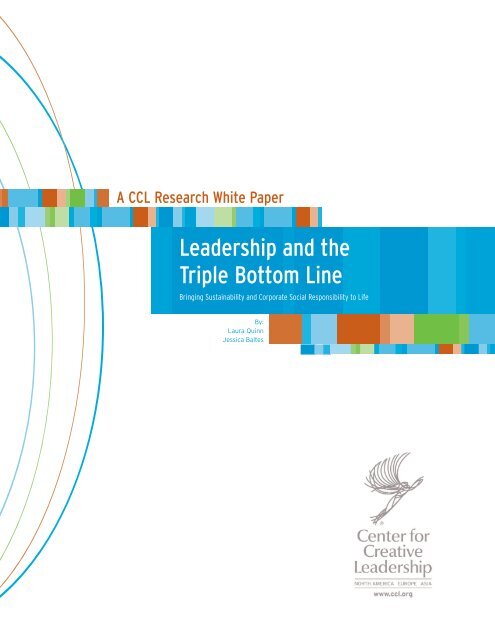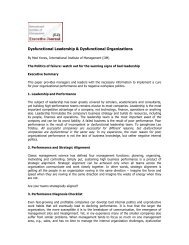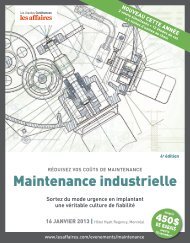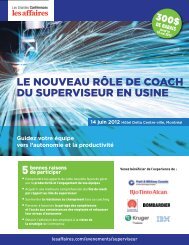Leadership and the Triple Bottom Line - LesAffaires.com
Leadership and the Triple Bottom Line - LesAffaires.com
Leadership and the Triple Bottom Line - LesAffaires.com
Create successful ePaper yourself
Turn your PDF publications into a flip-book with our unique Google optimized e-Paper software.
A CCL Research White Paper<br />
<strong>Leadership</strong> <strong>and</strong> <strong>the</strong><br />
<strong>Triple</strong> <strong>Bottom</strong> <strong>Line</strong><br />
!"#$%#$%&'()*+#$+,#-#*.&+$/&01"21"+*3&'14#+-&53)21$)#,#-#*.&*1&6#73<br />
By:<br />
Laura Quinn<br />
Jessica Baltes
C E N T E R F O R C R E AT I V E L E A D E R S H I P<br />
<strong>Leadership</strong> <strong>and</strong> <strong>the</strong> <strong>Triple</strong> <strong>Bottom</strong> <strong>Line</strong><br />
!"#$%#$&<br />
Executive summary<br />
Highlights<br />
Background<br />
TBL awareness <strong>and</strong> importance<br />
TBL leadership skills <strong>and</strong> actions<br />
TBL out<strong>com</strong>es <strong>and</strong> advantages<br />
Organizational strategy <strong>and</strong> <strong>the</strong> TBL<br />
Organizational culture <strong>and</strong> systems supporting or hindering TBL<br />
TBL behaviors: At home <strong>and</strong> at work<br />
Tips <strong>and</strong> resources<br />
Bios<br />
References<br />
3<br />
3<br />
4<br />
5<br />
5<br />
7<br />
8<br />
9<br />
11<br />
12<br />
13<br />
13<br />
Center for Creative <strong>Leadership</strong>, CCL ® , <strong>and</strong> its logo are registered trademarks owned by <strong>the</strong> Center for Creative <strong>Leadership</strong>. © 2007 Center for Creative <strong>Leadership</strong>. All rights reserved.
<strong>Leadership</strong> <strong>and</strong> <strong>the</strong> <strong>Triple</strong> <strong>Bottom</strong> <strong>Line</strong><br />
E " E C U T I V E S U M M A R Y<br />
The Ideas2Action (I2A) pro;ect is<br />
a Center for Creative <strong>Leadership</strong><br />
(CCL @ ) initiative bringing “ideas<br />
into action” by providing relevant<br />
<strong>and</strong> timely research via technology<br />
to our open-enrollment<br />
programs. In an attempt to<br />
underst<strong>and</strong> organizational sustainability,<br />
<strong>the</strong> 12A team collected<br />
data from Meptember through<br />
December 2006, gauging leader<br />
awareness <strong>and</strong> organizational<br />
implementation of <strong>the</strong> <strong>Triple</strong><br />
Rottom <strong>Line</strong> (TRL) concept.<br />
Two ma;or research methods were<br />
usedS A short, in-class survey via<br />
<strong>com</strong>puter kiosks <strong>and</strong> an in-depth<br />
Internet survey sent to participants<br />
2 weeks following <strong>the</strong>ir CCL<br />
eUperience. The Internet survey<br />
allowed <strong>the</strong> 12A team to better<br />
underst<strong>and</strong> <strong>the</strong> high-level trends<br />
that emerged from <strong>the</strong> in-class<br />
survey.<br />
Ve received 197 responses to <strong>the</strong><br />
in-class survey <strong>and</strong> 50 responses<br />
to <strong>the</strong> Internet survey. The typical<br />
respondent was a male (83 percent)<br />
between <strong>the</strong> ages of 41 <strong>and</strong><br />
50 (45 percent) representing <strong>the</strong><br />
eUecutive level (49 percent).<br />
HIGHLIGHTS<br />
Leaders believe that taking care of<br />
profits, people, <strong>and</strong> <strong>the</strong> planet are<br />
critical to organizational success, both<br />
now <strong>and</strong> in <strong>the</strong> future. !f <strong>the</strong> leaders<br />
we surveyed, 73 percent report <strong>the</strong> triple<br />
bottom line is currently important to<br />
organizational success, <strong>and</strong> 87 percent<br />
agree that <strong>the</strong> concept will be important<br />
to organizational success in <strong>the</strong> future.<br />
A leader with long-term vision <strong>and</strong> <strong>the</strong><br />
ability to <strong>com</strong>municate can influence<br />
o<strong>the</strong>rs to adopt his/her vision.<br />
According to leaders, <strong>the</strong> three most<br />
critical individual leadership <strong>com</strong>petencies<br />
necessary for adopting triple bottom line<br />
approaches include long-term view,<br />
<strong>com</strong>munication, <strong>and</strong> influence.<br />
Leaders believe <strong>the</strong>ir organizations<br />
can benefit from triple bottom line<br />
efforts. As identified by our surveyed<br />
leaders, <strong>the</strong> top advantages to adopting a<br />
triple bottom line approach are increased<br />
revenue <strong>and</strong> market share, increased<br />
employee retention, <strong>and</strong> increased <strong>com</strong>munity<br />
support.<br />
Taking on a TBL perspective requires<br />
a focused <strong>com</strong>mitment to long-term<br />
strategic thinking, planning, <strong>and</strong><br />
action. Ahen asked whe<strong>the</strong>r <strong>the</strong>ir organizations<br />
incorporate triple bottom line<br />
activities into <strong>the</strong>ir strategies <strong>and</strong> operations,<br />
11 out of 36 leaders answered Dyes.E<br />
!f <strong>the</strong> organizations that incorporate<br />
triple bottom line activities into <strong>the</strong>ir<br />
strategies <strong>and</strong> operations, more than 70<br />
percent came from <strong>the</strong> business sector.<br />
Implementing change means facing<br />
new obstacles <strong>and</strong> challenges. An organizationEs<br />
culture <strong>and</strong> systems must support<br />
this change. Gindings indicate <strong>the</strong><br />
three most critical organizational supports<br />
necessary for adopting triple bottom line<br />
approaches are integration of TIL into<br />
long-term strategies, goals, <strong>and</strong> measuresK<br />
employee training on TIL concepts,<br />
measures, <strong>and</strong> challengesK <strong>and</strong> leaders<br />
within <strong>the</strong> organization modeling TIL<br />
behaviors, both professionally <strong>and</strong> personally.<br />
Leaders <strong>and</strong> <strong>the</strong>ir organizations<br />
engage in sustainability efforts that<br />
focus on <strong>the</strong>ir <strong>com</strong>munities, recycling,<br />
<strong>and</strong> conservation programs. Individual<br />
leaders regularly donate to charitable<br />
organizations, recycle, <strong>and</strong> volunteer,<br />
while organizations regularly recycle,<br />
invest in <strong>the</strong>ir <strong>com</strong>munities, <strong>and</strong> conserve<br />
energy.<br />
3<br />
Center for Creative <strong>Leadership</strong>, CCL ® , <strong>and</strong> its logo are registered trademarks owned by <strong>the</strong> Center for Creative <strong>Leadership</strong>. © 2007 Center for Creative <strong>Leadership</strong>. All rights reserved.
<strong>Leadership</strong> <strong>and</strong> <strong>the</strong> <strong>Triple</strong> <strong>Bottom</strong> <strong>Line</strong><br />
B A C K G R O U N D<br />
The challenges of <strong>the</strong> 21st century are reNuiring businesses to fundamentally change<br />
<strong>the</strong> way <strong>the</strong>y operate. Issues such as climate change, natural resource depletion, <strong>and</strong> <strong>the</strong><br />
energy crisis are hitting organizations head on <strong>and</strong> dem<strong>and</strong>ing that attention be paid to<br />
aspects of <strong>the</strong> business beyond Nuarterly financial results. It is no longer acceptable to<br />
simply maOimize short-term shareholder value. Instead, firms must pay attention to<br />
<strong>the</strong> economic, social, <strong>and</strong> environmental effects of <strong>the</strong>ir operations P referred to as<br />
sustainability or corporate social responsibility.<br />
A relatively new concept in <strong>the</strong> business arena, sustainability is considered <strong>the</strong> 21st<br />
century business paradigm, as well as <strong>the</strong> price of entry for businesses looking to<br />
<strong>com</strong>pete for <strong>the</strong> long run. The most freNuently cited definition of sustainability is<br />
“!perating in ways that meet <strong>the</strong> needs of <strong>the</strong> present without <strong>com</strong>promising <strong>the</strong><br />
ability of future generations to meet <strong>the</strong>ir own needs.” 1<br />
The concept of sustainability addresses all aspects of an organization, including <strong>the</strong><br />
research <strong>and</strong> development of new products that do not emit toOins or use non-renewable<br />
materialsK innovation <strong>and</strong> creativity, where organizations figure out ways of using<br />
or minimizing wasteK marketing <strong>and</strong> advertising that addresses or supports local issues<br />
<strong>and</strong> social causesK <strong>and</strong> increased stakeholder engagement, creating dialogue with <strong>com</strong>munity<br />
partners, suppliers, <strong>com</strong>petitors, customers <strong>and</strong> representatives for <strong>the</strong> natural<br />
environment. Sustainability is Nuickly be<strong>com</strong>ing a fundamental market force ignited<br />
through customer, shareholder, <strong>and</strong> stakeholder dem<strong>and</strong>s.<br />
A framework to help operate within this sustainability lens is <strong>the</strong> TIL, which “focuses<br />
organizations not Tust on <strong>the</strong> economic value <strong>the</strong>y add, but also on <strong>the</strong> environmental<br />
value <strong>and</strong> social value <strong>the</strong>y add P <strong>and</strong> destroy. The three lines represent society, <strong>the</strong><br />
economy, <strong>and</strong> <strong>the</strong> environment. Society depends on <strong>the</strong> economy, <strong>and</strong> <strong>the</strong> economy<br />
depends on <strong>the</strong> global ecosystem, whose health represents <strong>the</strong> ultimate bottom line.” 2<br />
The test of a sustainable organization is <strong>the</strong> degree to which its operations can be<br />
continued indefinitely without negatively altering <strong>the</strong> factors that foster <strong>the</strong> eOistence<br />
<strong>and</strong> creation of healthy <strong>com</strong>munities <strong>and</strong> <strong>the</strong> natural environment.<br />
As with <strong>the</strong> implementation of any new program or movement, leadership plays a key<br />
role in successfully bringing about change. To underst<strong>and</strong> <strong>the</strong> leadership l<strong>and</strong>scape<br />
surrounding <strong>the</strong> TIL, we Nueried eOecutives attending our programs to learn more<br />
about <strong>the</strong>ir attitudes <strong>and</strong> actions regarding <strong>the</strong> TIL. Ae hoped to better underst<strong>and</strong><br />
<strong>the</strong> level of awareness <strong>and</strong> degree of importance leaders place on <strong>the</strong> TILK <strong>the</strong> out<strong>com</strong>es<br />
<strong>and</strong> advantages leaders connect to TIL effortsK how TIL efforts are integrated<br />
into day-to-day operationsK <strong>and</strong> how organizational culture <strong>and</strong> systems support or<br />
hinder TIL efforts.<br />
Center for Creative <strong>Leadership</strong>, CCL ® , <strong>and</strong> its logo are registered trademarks owned by <strong>the</strong> Center for Creative <strong>Leadership</strong>. © 2007 Center for Creative <strong>Leadership</strong>. All rights reserved.<br />
4
<strong>Leadership</strong> <strong>and</strong> <strong>the</strong> <strong>Triple</strong> <strong>Bottom</strong> <strong>Line</strong><br />
T B L AWA R E N E S S A N D I M P O R TA N C E<br />
!f <strong>the</strong> leaders surveyed, 45 percent indicated <strong>the</strong>y are aware of <strong>the</strong> TIL concept.<br />
Ahile this number appears to be low, it is not surprising given that most leaders within<br />
organizations are not currently rewarded or obliged by regulations to focus on all three<br />
levels of impact. At <strong>the</strong> same time, leaders may be unfamiliar with <strong>the</strong> specific TIL<br />
name, but grasp <strong>the</strong> broad concept of sustainability. The leaders most aware of <strong>the</strong><br />
TIL concept appear to work at <strong>the</strong> eOecutive <strong>and</strong> top management levels, most likely<br />
because <strong>the</strong> concept <strong>and</strong> measurement of corporate social responsibility is currently<br />
not widespread among operational level leaders.<br />
In contrast to <strong>the</strong> awareness response rate, 73 percent of all leaders surveyed believe<br />
<strong>the</strong> triple bottom line is important to organizational success now, while 87 percent<br />
agree <strong>the</strong> concept will be important to organizational success in <strong>the</strong> future. Wegardless<br />
of <strong>the</strong> specific name (triple bottom line, sustainability, or corporate social responsibility),<br />
leaders are realizing that taking care of profits, people, <strong>and</strong> <strong>the</strong> planet is critical to<br />
organizational success, both now <strong>and</strong> more importantly, in <strong>the</strong> future.<br />
This high awareness rate may indicate that todayEs leaders are eOposed to <strong>the</strong> concept<br />
of TIL from a number of different sources. Just a few years ago, one had to search to<br />
find anything published on sustainability or corporate social responsibility. [owever,<br />
todayEs popular publications, including Psychology Today, -ortune <strong>and</strong> -inancial Times<br />
publish articles <strong>and</strong> even entire issues dedicated to sustainability. The volume of<br />
publications supports <strong>the</strong> ideas of well-known author <strong>and</strong> business leader Gil<br />
Griend, of Natural Logic, Inc. who suggest “Ae may have reached <strong>the</strong> tipping point<br />
for sustainability.” 3<br />
T B L L E A D E R S H I P S K I L L S A N D A C T I O N S<br />
Gostering leadership <strong>com</strong>petencies for superior organizational performance has always<br />
been vitally important. TodayEs business environment is increasingly <strong>com</strong>pleO <strong>and</strong> globally<br />
integrated, <strong>and</strong> is fur<strong>the</strong>r <strong>com</strong>plicated by <strong>the</strong> additional layers of accountability<br />
within <strong>the</strong> emerging framework of <strong>the</strong> triple bottom line. The identification <strong>and</strong> development<br />
of critical leadership <strong>com</strong>petencies that address <strong>the</strong> reNuirements of TIL will<br />
put an organization on <strong>the</strong> path to <strong>com</strong>petitive advantage.<br />
According to surveyed leaders, <strong>the</strong> three most critical individual leadership <strong>com</strong>petencies<br />
necessary for adopting triple bottom line approaches are long-term view, <strong>com</strong>munication,<br />
<strong>and</strong> influence.<br />
Survey respondents answered <strong>the</strong> Nuestion, “Please choose <strong>the</strong> top three leadership<br />
<strong>com</strong>petencies you feel are necessary for leaders who are asked to adopt triple bottom<br />
line approaches.” The results are listed in Gigure 1 on page 6.<br />
Center for Creative <strong>Leadership</strong>, CCL ® , <strong>and</strong> its logo are registered trademarks owned by <strong>the</strong> Center for Creative <strong>Leadership</strong>. © 2007 Center for Creative <strong>Leadership</strong>. All rights reserved.<br />
5
<strong>Leadership</strong> <strong>and</strong> <strong>the</strong> <strong>Triple</strong> <strong>Bottom</strong> <strong>Line</strong><br />
T B L L E A D E R S H I P S K I L L S A N D A C T I O N S (c o n t i n u e d )<br />
LEADERSHIP COMPETENCIES<br />
Long-term view<br />
Communication<br />
Influence<br />
Mcanning <strong>the</strong> eUternal environment<br />
Collaboration<br />
Wnderst<strong>and</strong>ing ano<strong>the</strong>rXs perspective<br />
Mystems thinking<br />
YleUibility<br />
Embracing diversity<br />
[isk-taking<br />
Inclusivity<br />
Roundary spanning<br />
Mtorytelling<br />
89:;5
<strong>Leadership</strong> <strong>and</strong> <strong>the</strong> <strong>Triple</strong> <strong>Bottom</strong> <strong>Line</strong><br />
T B L O U T C O M E S & A D VA N TA G E S<br />
According to leaders, <strong>the</strong> top three advantages to adopting a triple bottom line<br />
approach are increased revenue <strong>and</strong> market share, increased employee retention, <strong>and</strong><br />
increased <strong>com</strong>munity support.<br />
Increased revenue <strong>and</strong> market share suggests that leaders believe <strong>the</strong>ir organizations<br />
can benefit a great deal from triple bottom line efforts. The market share advantage<br />
also shows that leaders believe customers <strong>and</strong> o<strong>the</strong>r stakeholders will respond positively<br />
to triple bottom line efforts. It is clear <strong>the</strong>se leaders see an economic value to <strong>the</strong><br />
triple bottom lineK it can provide cost savings as well as revenues from innovations <strong>and</strong><br />
new market opportunities.<br />
Increased employee retention also was seen as an advantage of implementing <strong>the</strong> triple<br />
bottom line. Many firms are realizing that having a strong sustainability or CSW program<br />
helps with both recruitment <strong>and</strong> retention of talent. A recent study by Stanford<br />
bniversity shows that MIA graduates will take c13d lower in annual salary to work<br />
for a DresponsibleE <strong>com</strong>pany (CSW Weputation Effects on MIA Job Choice, Stanford<br />
bniversity, 2003). Ano<strong>the</strong>r study found that employees in <strong>com</strong>panies with strong sustainability<br />
programs are happier, more satisfied, <strong>and</strong> have longer retention rates<br />
(Corporate Wesponsibilityf Iurden or !pportunity, Business6eek Wesearch Services g<br />
Grant Thompson, 2007). Leaders viewed increased <strong>com</strong>munity support as ano<strong>the</strong>r<br />
advantage to <strong>the</strong> triple bottom line. Local <strong>com</strong>munities can have a strong influence on<br />
a firmEs Dlicense to operateE. If a <strong>com</strong>pany engages <strong>the</strong> <strong>com</strong>munity around <strong>the</strong>ir environmental<br />
<strong>and</strong> social impacts <strong>and</strong> itEs role in addressing <strong>com</strong>munity issues, it presents<br />
<strong>the</strong> <strong>com</strong>pany as a good corporate citizen <strong>and</strong> partner, thus opening <strong>the</strong> door for dialogue<br />
<strong>and</strong> positive stakeholder relationships. The TIL perspective also results in organizations<br />
avoiding regulatory issues, bad publicity, <strong>and</strong> angering special interest groups.<br />
Vhat is <strong>the</strong> ultimate organizational advantage to <strong>the</strong> triple bottom linea<br />
TRIPLE BOTTOM LINE ADVANTAGES<br />
Increased revenue/market share<br />
Increased employee retention<br />
Increased <strong>com</strong>munity support<br />
[educed risk<br />
^<strong>the</strong>r<br />
Positive public relations<br />
[educed costs<br />
Ease of recruitment<br />
No advantage<br />
PERCENTAGE<br />
28%<br />
19%<br />
17%<br />
17%<br />
11%<br />
6%<br />
3%<br />
0%<br />
0%<br />
89:;5<br />
Center for Creative <strong>Leadership</strong>, CCL ® , <strong>and</strong> its logo are registered trademarks owned by <strong>the</strong> Center for Creative <strong>Leadership</strong>. © 2007 Center for Creative <strong>Leadership</strong>. All rights reserved.<br />
7
<strong>Leadership</strong> <strong>and</strong> <strong>the</strong> <strong>Triple</strong> <strong>Bottom</strong> <strong>Line</strong><br />
T B L O U T C O M E S A N D A D VA N TA G E S (c o n t i n u e d )<br />
In addition, leaders viewed increased <strong>com</strong>munity support as ano<strong>the</strong>r advantage to <strong>the</strong><br />
triple bottom line. !rganizations that support <strong>the</strong> <strong>com</strong>munity affect <strong>the</strong>ir surroundings<br />
beyond <strong>the</strong> walls of <strong>the</strong> organization, through educational development, charitable<br />
events, <strong>and</strong> visibility of issues. A by-product of <strong>the</strong>se advantages is reduced risk, which<br />
means that organizations incorporating triple bottom line efforts are seen as safer<br />
investments, making it easier for <strong>the</strong>m to procure funds. The triple bottom line also<br />
results in organizations avoiding legalities with governments, bad publicity, <strong>and</strong> angering<br />
special interest groups.<br />
A savvy business might use <strong>the</strong>se advantages to help create a framework that rewards<br />
actions <strong>and</strong> decisions made by its leadership supporting sustainability <strong>and</strong> <strong>the</strong> TIL.<br />
These views support AillardEs (2002) research documenting <strong>the</strong> sustainability advantage,<br />
which claims <strong>the</strong> TIL contributes to <strong>the</strong> hiring of top talent, higher retention of<br />
top talent, increased employee productivity, reduced manufacturing eOpenses, reduced<br />
eOpenses at <strong>com</strong>mercial sites, increased revenues <strong>and</strong> market share, reduced risk, <strong>and</strong><br />
easier financing.<br />
O R G A N I C AT I O N A L S T R AT E GY A N D T H E T B L<br />
Taking on a TIL perspective reNuires a focused <strong>com</strong>mitment through long-term<br />
strategic thinking, planning, alignment, <strong>and</strong> implementation. Ahen <strong>com</strong>panies champion<br />
corporate sustainability, <strong>the</strong> challenge be<strong>com</strong>es how to incorporate triple bottom<br />
line principles into an organizationEs operations. Two concepts that organizations must<br />
underst<strong>and</strong> to successfully integrate <strong>the</strong> triple bottom line with <strong>com</strong>pany strategy is<br />
that sustainability reNuires innovation, <strong>and</strong> sustainability strategies must be customized<br />
(Placet et al., 2005).<br />
Ahen asked whe<strong>the</strong>r <strong>the</strong>ir organizations incorporate triple bottom line activities into<br />
<strong>the</strong>ir strategies <strong>and</strong> operations, 11 out of 36 participants answered Dyes.E !f <strong>the</strong> 11 participant<br />
organizations that incorporate triple bottom line activities into <strong>the</strong>ir strategies<br />
<strong>and</strong> operations, more than 70 percent came from <strong>the</strong> business sector. Iased on this set<br />
of responses, <strong>the</strong> size of <strong>the</strong> organization did not have any impact on whe<strong>the</strong>r it was<br />
incorporating TIL activities.<br />
8<br />
Center for Creative <strong>Leadership</strong>, CCL ® , <strong>and</strong> its logo are registered trademarks owned by <strong>the</strong> Center for Creative <strong>Leadership</strong>. © 2007 Center for Creative <strong>Leadership</strong>. All rights reserved.
<strong>Leadership</strong> <strong>and</strong> <strong>the</strong> <strong>Triple</strong> <strong>Bottom</strong> <strong>Line</strong><br />
O R G A N I C AT I O N A L S T R AT E GY A N D T H E T B L (c o n t i n u e d )<br />
OVERALL<br />
Total<br />
ORGANIBATION LEVEL<br />
Top<br />
EUecutive<br />
Wpper Middle<br />
Middle<br />
NUMBER OF EMPLOYEES<br />
10,000 or more<br />
5,000 to 9,999<br />
2<br />
T R E N D 5 : T H E W O R L D O F I N T E R R U P T I O N<br />
1,000 to 4,999<br />
5<br />
100 to 999<br />
Does your organization incorporate triple bottom line<br />
activities into its strategies <strong>and</strong> operationsa<br />
YES<br />
11<br />
YES<br />
0<br />
8<br />
0<br />
3<br />
YES<br />
3<br />
1<br />
89:;5
<strong>Leadership</strong> <strong>and</strong> <strong>the</strong> <strong>Triple</strong> <strong>Bottom</strong> <strong>Line</strong><br />
O R G A N I C AT I O N A L C U LT U R E A N D S Y S T E M S S U P P O R T I N G<br />
O R H I N D E R I N G T B L (c o n t i n u e d )<br />
BIGGEST OBSTACLES<br />
Not underst<strong>and</strong>ing/Not aware of TRL<br />
Yinancial focus a priority<br />
<strong>Leadership</strong> c organizational culture<br />
Lack of measures for TRL<br />
Mhort term thinking<br />
RESPONSE RATE<br />
30%<br />
27%<br />
24%<br />
9%<br />
10%<br />
89:;5
<strong>Leadership</strong> <strong>and</strong> <strong>the</strong> <strong>Triple</strong> <strong>Bottom</strong> <strong>Line</strong><br />
T B L B E H AV I O R S : AT H O M E A N D AT W O R K<br />
There is no Nuestion about <strong>the</strong> strong link between at-home behaviors <strong>and</strong> <strong>the</strong> actions<br />
adopted in organizations. As such, data was collected from <strong>the</strong> in-class survey to eOamine<br />
what leaders <strong>and</strong> <strong>the</strong>ir organizations are currently doing to support <strong>and</strong> demonstrate<br />
<strong>the</strong> TIL concepts.<br />
Individuals were asked to list <strong>the</strong> efforts <strong>the</strong>y regularly engage in at home or work, <strong>and</strong><br />
<strong>the</strong> efforts in which <strong>the</strong>ir organizations regularly engage.<br />
INDIVIDUAL SUSTAINABILITY EFFORTS<br />
Donate to charitable organizations<br />
[ecycle<br />
eolunteer in my <strong>com</strong>munity<br />
Energy c water conservation<br />
Merve on <strong>com</strong>munity boards<br />
Drive a fuel-efficient vehicle<br />
Mocial c environmental responsible investing<br />
Take public transportation<br />
Participate in a sustainability awareness group<br />
None of <strong>the</strong> above<br />
RESPONSE RATE<br />
92%<br />
79%<br />
59%<br />
58%<br />
39%<br />
22%<br />
15%<br />
14%<br />
9%<br />
2%<br />
89:;5
<strong>Leadership</strong> <strong>and</strong> <strong>the</strong> <strong>Triple</strong> <strong>Bottom</strong> <strong>Line</strong><br />
T I P S A N D R E S O U R C E S<br />
!<br />
!<br />
!<br />
!<br />
TIL is not an ei<strong>the</strong>r/or issue, ra<strong>the</strong>r it is a both/<strong>and</strong> opportunity to increase<br />
<strong>com</strong>petitive advantage throughf<br />
! Improved recruitment/retention<br />
! Increased employee morale <strong>and</strong> productivity<br />
! Weduced costs, eOpenses, <strong>and</strong> risk<br />
! Ietter <strong>com</strong>munity relations <strong>and</strong> reputation<br />
bnderst<strong>and</strong> <strong>the</strong> organizationEs attitudes <strong>and</strong> <strong>the</strong> value placed on pursuing a TIL<br />
agenda before launching into a maTor change effort<br />
A TIL strategy is not enoughK it must be<strong>com</strong>e integrated into <strong>the</strong> day-to-day<br />
operations <strong>and</strong> be aligned through <strong>the</strong> systems <strong>and</strong> processes of <strong>the</strong> organization<br />
Develop Dleadership capacityE to deal with TIL challenges <strong>and</strong> opportunities with a<br />
focus onf<br />
! Integrative/systemic thinking<br />
! Ialance of long-term perspective with short-term results<br />
! Stakeholder engagement<br />
Check out <strong>the</strong> following for support <strong>and</strong> ideas for implementing TBL:<br />
!<br />
!<br />
!<br />
!<br />
!<br />
Aebsites<br />
! www.sustainablebusiness.<strong>com</strong><br />
! www.greenbiz.<strong>com</strong><br />
! www.wiserbusiness.org<br />
! www.<strong>the</strong>dailygreen.<strong>com</strong><br />
Member !rganizations<br />
! Iusiness for Social Wesponsibility (www.bsr.org)<br />
! Aorld Iusiness Council Gor Sustainable Development (www.wbcsd.org)<br />
Developing Leaders for Sustainability<br />
! Center for Creative <strong>Leadership</strong> (www.ccl.org)<br />
! Globally Wesponsible <strong>Leadership</strong> Initiative (www.globallyresponsibleleaders.net)<br />
Principles/Weporting<br />
! The Natural Step (www.tns.org)<br />
! bN Global Compact (www.unglobal<strong>com</strong>pact.org)<br />
! Global Weporting Initiative (www.globalreporting.org)<br />
Iooks<br />
! The %ustainability /<strong>and</strong>book, 2007<br />
! Leading Change Toward %ustainability, by Iob Doppelt, 2003<br />
! Cradle to Cradle, by Iill McDonough <strong>and</strong> Michael Iraungart, 2002<br />
! The %ustainability Advantage, by Iob Aillard, 2002<br />
Center for Creative <strong>Leadership</strong>, CCL ® , <strong>and</strong> its logo are registered trademarks owned by <strong>the</strong> Center for Creative <strong>Leadership</strong>. © 2007 Center for Creative <strong>Leadership</strong>. All rights reserved.<br />
12
<strong>Leadership</strong> <strong>and</strong> <strong>the</strong> <strong>Triple</strong> <strong>Bottom</strong> <strong>Line</strong><br />
B I O<br />
Laura Quinn is a senior associate at <strong>the</strong> Center for Creative <strong>Leadership</strong>K she is passionate<br />
about helping organizations underst<strong>and</strong> <strong>and</strong> adopt sustainability principles.<br />
Laura leadEs <strong>the</strong> CenterEs research efforts in sustainability/corporate social responsibility.<br />
She has an undergraduate degree in business from <strong>the</strong> bniversity of Colorado at<br />
Ioulder <strong>and</strong> a Ph.D. in !rganizational Communication from <strong>the</strong> bniversity of TeOas<br />
at Austin.<br />
Jessica Baltes is a research associate at <strong>the</strong> Center for Creative <strong>Leadership</strong> where she<br />
is involved in research <strong>and</strong> evaluation. Jessica has a long st<strong>and</strong>ing interest in sustainability/corporate<br />
social responsibility <strong>and</strong> is a founding member of <strong>the</strong> <strong>Leadership</strong> for a<br />
Sustainability Aorld taskforce on CCLEs Colorado Springs campus. She graduated from<br />
<strong>the</strong> bniversity of Aisconsin with a I.S. in business <strong>and</strong> from <strong>the</strong> bniversity of<br />
Colorado with a masterEs degree in Iusiness Administration.<br />
F O O T N O T E S<br />
1 :ur Common







